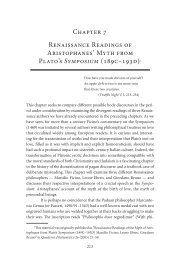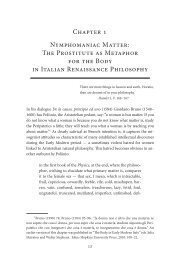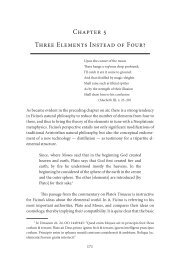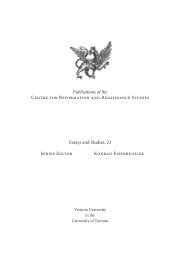Chapter 2 Matter as a Mirror: Marsilio Ficino and Renaissance ...
Chapter 2 Matter as a Mirror: Marsilio Ficino and Renaissance ...
Chapter 2 Matter as a Mirror: Marsilio Ficino and Renaissance ...
You also want an ePaper? Increase the reach of your titles
YUMPU automatically turns print PDFs into web optimized ePapers that Google loves.
104<br />
Disreputable Bodies<br />
through these forms, is false.” 176 The following description from the medieval<br />
Roman de la Rose of a crystal at the bottom of the fountain of Narcissus gives<br />
a very accurate synopsis (in the truest sense of the word) of ide<strong>as</strong> about mirrors<br />
<strong>and</strong> translucent objects <strong>as</strong> potentially demonic <strong>and</strong> even lethal objects,<br />
but also erotically attractive:<br />
The crystal is so marvellous <strong>and</strong> h<strong>as</strong> such power over that<br />
whole place, with its trees <strong>and</strong> flowers <strong>and</strong> everything<br />
adorning the garden, is revealed there in due order. Just <strong>as</strong><br />
things placed in front of a mirror are reflected in it, <strong>and</strong> their<br />
appearance <strong>and</strong> colour are seen quite plainly, exactly so […]<br />
does the crystal truly disclose the whole of the garden to<br />
him who gazes into the water. […] And there is nothing so<br />
small, so secret, or so hidden that it is not displayed there, <strong>as</strong><br />
if it were etched into the crystal. This is the perilous mirror<br />
where proud Narcissus looked at his face <strong>and</strong> his bright<br />
eyes, <strong>and</strong> afterwards lay stretched out in death. Whoever<br />
looks at himself in this mirror can have no help or remedy<br />
against seeing something which causes him promptly to fall<br />
in love. […] for Cupid, Venus’ son, sowed here the seed of<br />
Love which covers the whole spring; here he sets his nets <strong>and</strong><br />
snares to trap young men <strong>and</strong> maidens. […] I w<strong>as</strong> happy then<br />
to linger, admiring the spring <strong>and</strong> the crystals revealed to a<br />
thous<strong>and</strong> things around me. 177<br />
In the Roman de la Rose the mirror functions <strong>as</strong> an advanced tool of<br />
perception (with a remarkable capacity for synthesis) that represents objects<br />
that otherwise would p<strong>as</strong>s unnoticed. As w<strong>as</strong> the c<strong>as</strong>e with the mirror of providence,<br />
the crystal at the bottom of the font is able to “capture” the objects it<br />
reflects, to dominate them <strong>and</strong> even to kill them; this optical device exerts considerable<br />
<strong>and</strong> highly uncanny power over the things it reflects. In the Roman<br />
de la Rose, the fate of Narcissus is sealed by his looking into a crystal, which<br />
176 Ed. Lindberg (1983) 146: “falsa est illa opinio vulgi quae estimat form<strong>as</strong> seu species<br />
imprimi in speculo ad hoc, ut visus eius contemplatur per illam formam.”<br />
177 Romance of the Rose vs. 1530–1532; On the Narcissus episode in this work, see<br />
Vinge (1967) 81–32 with references; Vitti (1992) 53–57.







